Animals are featured in many favorite childhood books, and adults also often gravitate to books about animals to share with children. Perhaps this is the case because animals are often so majestic in their natural settings but also on the home front, because they remind readers of truths about themselves. Here are some of my recent favorite titles in which animals are either featured center stage or play an important role in the storyline.
Ages 4–8
Chicken Lily. Lori Mortensen. Ill. Nina Victor Crittenden. 2016. Henry Holt.
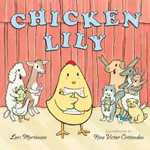 Public speaking is an activity that makes many brave souls turn chicken. Although Lily, an actual chicken, does many things quite well, she is certainly not a risk taker. When her teacher plans a poetry jam, Lily does everything she possibly can to avoid performing. But then once she figures out how to write poetry and is forced to share her lines onstage, she actually feels validated by the reaction of others as everything turns out fine. Although Lily is just a chicken, she has overcome at least one fear by the book’s conclusion. The illustrations, created with watercolor, pen, and ink, are simple yet complement the story, which is filled with animals but also with lessons for humans.
Public speaking is an activity that makes many brave souls turn chicken. Although Lily, an actual chicken, does many things quite well, she is certainly not a risk taker. When her teacher plans a poetry jam, Lily does everything she possibly can to avoid performing. But then once she figures out how to write poetry and is forced to share her lines onstage, she actually feels validated by the reaction of others as everything turns out fine. Although Lily is just a chicken, she has overcome at least one fear by the book’s conclusion. The illustrations, created with watercolor, pen, and ink, are simple yet complement the story, which is filled with animals but also with lessons for humans.
Sky Pig. Jan L. Coates. Ill. Suzanne Del Rizzo. 2016. Pajama Press.
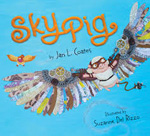 Because Ollie, a pig, dreams of being able to fly, his human friend Jack tries all sorts of strategies to help him accomplish his ambitions. Still, even though they tie together branches, use a kite and its string, and even affix wings to Ollie’s back, his time aloft is all too brief. When a hot air balloon offers possibilities for flight, the two seize the moment, and Ollie rises into the air. This child-friendly story provides a message about persistence and friendship while the illustrations, created with plasticine, polymer clay, paper collage, and various found objects including milkweed fluff and watch gears, are particularly eye-catching.
Because Ollie, a pig, dreams of being able to fly, his human friend Jack tries all sorts of strategies to help him accomplish his ambitions. Still, even though they tie together branches, use a kite and its string, and even affix wings to Ollie’s back, his time aloft is all too brief. When a hot air balloon offers possibilities for flight, the two seize the moment, and Ollie rises into the air. This child-friendly story provides a message about persistence and friendship while the illustrations, created with plasticine, polymer clay, paper collage, and various found objects including milkweed fluff and watch gears, are particularly eye-catching.
They All Saw a Cat. Brendan Wenzel. 2016. Chronicle.
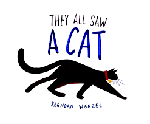 Perspective is what matters most when looking at anything, as is vividly illustrated in this picture book using colored pencil, oil pastels, acrylic paint, watercolor, charcoal, markers, and pencils to depict how 12 different animals see a feline. Not only do we all see different things when we view the objects in our world, but our perspectives, like those of the animals in this book, are different as well. There is even one illustration showing how the cat sees itself when he peers into the water that provides him a mirror to gaze at his own appearance. The rhythmic text moves as fluidly as that slinky feline saunters across the book’s pages. Young readers are sure to enjoy this imaginative journey through nature and revel at the various perspectives on one cat offered here. After all, although all these animals saw a cat, they didn’t all see the same thing.
Perspective is what matters most when looking at anything, as is vividly illustrated in this picture book using colored pencil, oil pastels, acrylic paint, watercolor, charcoal, markers, and pencils to depict how 12 different animals see a feline. Not only do we all see different things when we view the objects in our world, but our perspectives, like those of the animals in this book, are different as well. There is even one illustration showing how the cat sees itself when he peers into the water that provides him a mirror to gaze at his own appearance. The rhythmic text moves as fluidly as that slinky feline saunters across the book’s pages. Young readers are sure to enjoy this imaginative journey through nature and revel at the various perspectives on one cat offered here. After all, although all these animals saw a cat, they didn’t all see the same thing.
Ages 9–11
Beetle Boy (The Battle of the Beetles). M.G. Leonard. 2016. Chicken House/Scholastic.
 Twelve-year-old Darkus Cuttle comes to stay with his eccentric Uncle Max after his scientist father disappears. A rhinoceros beetle named Baxter befriends Darkus and leads the boy and his new friends, Virginia and Bertolt, to the beetle-filled house next door amid a human pack rat’s warren of furniture, clothing, and debris. As it turns out, the beetles next door are highly intelligent, able to follow orders, and seemingly capable of thinking for themselves. The beetles and the youngsters battle with their nemesis, the cold-hearted Lucretia Cutter, who is determined to get her hands on those beetles, no matter the price. Readers will be quickly swept up by this fast-moving story, filled with interesting details about beetles and representing a cautionary example of the perils of genetic engineering.
Twelve-year-old Darkus Cuttle comes to stay with his eccentric Uncle Max after his scientist father disappears. A rhinoceros beetle named Baxter befriends Darkus and leads the boy and his new friends, Virginia and Bertolt, to the beetle-filled house next door amid a human pack rat’s warren of furniture, clothing, and debris. As it turns out, the beetles next door are highly intelligent, able to follow orders, and seemingly capable of thinking for themselves. The beetles and the youngsters battle with their nemesis, the cold-hearted Lucretia Cutter, who is determined to get her hands on those beetles, no matter the price. Readers will be quickly swept up by this fast-moving story, filled with interesting details about beetles and representing a cautionary example of the perils of genetic engineering.
Strudel’s Forever Home. Martha Freeman. 2016. Holiday House.
 Sometimes a dog’s point of view reveals truths about humans that might not be readily apparent, as is shown in this story told by Strudel, a dachshund at a Philadelphia animal shelter. The friendly dog is delighted when Jake, who has been reading to the animals in order to improve his reading skills, impulsively decides to adopt him. But Jake’s family hasn’t made any plans for Strudel’s stay, and they don’t even have dog food for his new pet. Drawing inspiration from the adventure story Jack has been reading to him, Strudel is determined to live up to the fictional dog’s heroics. Nevertheless, as might be expected, he makes mistakes as he tries to fit into his new family such as attacking the garden hose because it resembles a snake. In the end, Strudel proves his worth as he helps Jake deal with bullying by some would-be thugs and senses that Mom’s boyfriend, Arnie, is untrustworthy. Readers will find Jake’s dilemmas quite realistic, and having a dog’s eye view of the action provides funny perspectives on daily life. This book amuses while also encouraging readers to think about the consequences of their actions and how to deal with those who are trying to take advantage of them.
Sometimes a dog’s point of view reveals truths about humans that might not be readily apparent, as is shown in this story told by Strudel, a dachshund at a Philadelphia animal shelter. The friendly dog is delighted when Jake, who has been reading to the animals in order to improve his reading skills, impulsively decides to adopt him. But Jake’s family hasn’t made any plans for Strudel’s stay, and they don’t even have dog food for his new pet. Drawing inspiration from the adventure story Jack has been reading to him, Strudel is determined to live up to the fictional dog’s heroics. Nevertheless, as might be expected, he makes mistakes as he tries to fit into his new family such as attacking the garden hose because it resembles a snake. In the end, Strudel proves his worth as he helps Jake deal with bullying by some would-be thugs and senses that Mom’s boyfriend, Arnie, is untrustworthy. Readers will find Jake’s dilemmas quite realistic, and having a dog’s eye view of the action provides funny perspectives on daily life. This book amuses while also encouraging readers to think about the consequences of their actions and how to deal with those who are trying to take advantage of them.
The Tragic Tale of the Great Auk. Jan Thornhill. 2016. Groundwood/House of Anansi.
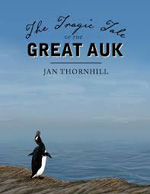 Young environmentalists will certainly be interested in this nonfiction title describing the demise of a species, the Great Auk, the last of which was seen before the start of the Civil War. Thousands of these birds, adept fishers and swimmers, once inhabited the North Atlantic region. The author describes how nature and humans spelled disaster for these creatures that were awkward on land and unable to fly due to their very small wings. Because the Great Auks were so easy to hunt, they provided food for explorers arriving in the area and were often burned for fuel. Eventually, with a reduced habitat and smaller numbers, they became prized for private collections because of their rarity. The author tells the Great Auk’s story in an engaging fashion, identifying turning points from which things could have resulted differently for this species. At the book’s conclusion, Thornhill performs an interesting switch by explaining how the demise of this oddly appealing bird eventually led to the thriving puffin population on Funk Island. Accompanied by exquisitely rendered drawings, created on a computer with Corel Painter, the text will enthrall and sadden readers, perhaps reminding them that when a species is gone, it has disappeared forever.
Young environmentalists will certainly be interested in this nonfiction title describing the demise of a species, the Great Auk, the last of which was seen before the start of the Civil War. Thousands of these birds, adept fishers and swimmers, once inhabited the North Atlantic region. The author describes how nature and humans spelled disaster for these creatures that were awkward on land and unable to fly due to their very small wings. Because the Great Auks were so easy to hunt, they provided food for explorers arriving in the area and were often burned for fuel. Eventually, with a reduced habitat and smaller numbers, they became prized for private collections because of their rarity. The author tells the Great Auk’s story in an engaging fashion, identifying turning points from which things could have resulted differently for this species. At the book’s conclusion, Thornhill performs an interesting switch by explaining how the demise of this oddly appealing bird eventually led to the thriving puffin population on Funk Island. Accompanied by exquisitely rendered drawings, created on a computer with Corel Painter, the text will enthrall and sadden readers, perhaps reminding them that when a species is gone, it has disappeared forever.
Wild Blood (Horses of the Dawn). Kathryn Lasky. 2016. Scholastic.
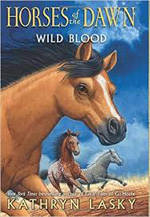 In this triumphant conclusion to the popular equine-dominated trilogy, the First Herd is heading toward the mountains and the promise of sweet grass and freedom. The ruthless conquistador El Miedo is determined to find gold and replenish his herd with Estrella and the horses following her. Through trickery, the filly Estrella and the young boy Tijo are captured, and things look quite hopeless. But El Miedo’s overworked mules and some of his horses plot an escape. Filled with characters that readers will love and some they will hate, this fast-paced action story celebrates heroism, including the heroism that may lie within even the most selfish of creatures. Despite the challenges they faced, those horses also had a lot of unexpected allies. By the time the horses reach their destination and possibly their destiny, readers may feel their hearts swelling with pride at how far the characters have traveled.
In this triumphant conclusion to the popular equine-dominated trilogy, the First Herd is heading toward the mountains and the promise of sweet grass and freedom. The ruthless conquistador El Miedo is determined to find gold and replenish his herd with Estrella and the horses following her. Through trickery, the filly Estrella and the young boy Tijo are captured, and things look quite hopeless. But El Miedo’s overworked mules and some of his horses plot an escape. Filled with characters that readers will love and some they will hate, this fast-paced action story celebrates heroism, including the heroism that may lie within even the most selfish of creatures. Despite the challenges they faced, those horses also had a lot of unexpected allies. By the time the horses reach their destination and possibly their destiny, readers may feel their hearts swelling with pride at how far the characters have traveled.
Ages 12–14
The Best Worst Thing. Kathleen Lane. 2016. Little, Brown.
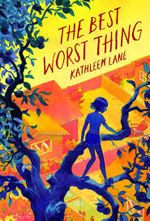 Middle grader Maggie Alder worries about a lot of things, including the start of a new school year and her family’s safety. She dreads starting middle school—and for good reason—because many of her classmates seem to have changed and become more interested in makeup and clothing than their previous interests. She is gravely concerned about the fate of rabbits being raised by her neighbor Mr. Gullick, and she worries about another neighbor, Gordy, and the gun he’s been promised for his upcoming birthday. As she devises a plan of action to save the rabbits, she finds unexpected friendship even while resorting to odd coping strategies such as repeating statements and holding her breath. Readers will fall in love with Maggie and this intense story filled with hope, heart, and determination and its glimpse into the often-awkward transition into middle grades, while holding their own breath to see how everything turns out. One of the book’s strengths is how it handles the challenges faced by its characters, often hinting at what’s going on in their lives rather than providing detailed descriptions of what ails each of them.
Middle grader Maggie Alder worries about a lot of things, including the start of a new school year and her family’s safety. She dreads starting middle school—and for good reason—because many of her classmates seem to have changed and become more interested in makeup and clothing than their previous interests. She is gravely concerned about the fate of rabbits being raised by her neighbor Mr. Gullick, and she worries about another neighbor, Gordy, and the gun he’s been promised for his upcoming birthday. As she devises a plan of action to save the rabbits, she finds unexpected friendship even while resorting to odd coping strategies such as repeating statements and holding her breath. Readers will fall in love with Maggie and this intense story filled with hope, heart, and determination and its glimpse into the often-awkward transition into middle grades, while holding their own breath to see how everything turns out. One of the book’s strengths is how it handles the challenges faced by its characters, often hinting at what’s going on in their lives rather than providing detailed descriptions of what ails each of them.
Fortune Falls. Jenny Goebel. 2016. Scholastic.
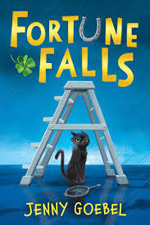 Sadie Bleeker is a very unlucky girl living in Fortune Falls, a town where luck is most valued. Unfortunately for Sadie, those who are lucky continue to multiply their luck, and those less fortunate such as she seem to have little luck at all. As her 12th birthday approaches, Sadie can only hope that her birthday wish will turn things around so she can stay with her family and not be sent off to boarding school for others as unlucky as she is. When her beloved dog, Wink, disappears into the dreaded cemetery and even her best friend, Cooper, seems to have forsaken her as her luck goes from bad to even worse, Sadie is just about ready to give up completely. In search of luck, Sadie finds it in the most unlikely form, that of Jinx, the black cat lurking in her path. How horrible it would be to feel doomed to a luckless future at the age of 12 as you were sorted into the undesirable pile.
Sadie Bleeker is a very unlucky girl living in Fortune Falls, a town where luck is most valued. Unfortunately for Sadie, those who are lucky continue to multiply their luck, and those less fortunate such as she seem to have little luck at all. As her 12th birthday approaches, Sadie can only hope that her birthday wish will turn things around so she can stay with her family and not be sent off to boarding school for others as unlucky as she is. When her beloved dog, Wink, disappears into the dreaded cemetery and even her best friend, Cooper, seems to have forsaken her as her luck goes from bad to even worse, Sadie is just about ready to give up completely. In search of luck, Sadie finds it in the most unlikely form, that of Jinx, the black cat lurking in her path. How horrible it would be to feel doomed to a luckless future at the age of 12 as you were sorted into the undesirable pile.
All Ages
National Geographic Kids Ultimate Explorer Field Guide: Birds. Julie Beer. 2016. National Geographic.
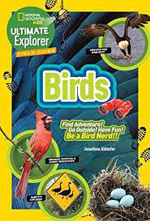 Brimming with 175 photographs and numerous tips for novice birdwatchers, this comprehensive but compact field guide offers basic information about birds. In fact, it provides all that is needed to begin the hobby of birding other than binoculars and a notebook. The book is organized according to regions and includes helpful maps showing the range of various birds. The text also includes bird-related activities and jokes. There is even information about birds that closely resemble one another and can fool someone just learning to identify various species. Perfect as a primer for novice birders, this field guide could prove that the family that looks for birds together may spend more time together.
Brimming with 175 photographs and numerous tips for novice birdwatchers, this comprehensive but compact field guide offers basic information about birds. In fact, it provides all that is needed to begin the hobby of birding other than binoculars and a notebook. The book is organized according to regions and includes helpful maps showing the range of various birds. The text also includes bird-related activities and jokes. There is even information about birds that closely resemble one another and can fool someone just learning to identify various species. Perfect as a primer for novice birders, this field guide could prove that the family that looks for birds together may spend more time together.
Barbara A. Ward teaches graduate and undergraduate courses in literacy at Washington State University, Pullman. She spent 25 years teaching in the public schools of New Orleans, where she worked with students at every grade level, from kindergarten through high school as well as several ability levels. She is certified in elementary education, English education, and gifted education. She holds a bachelor's in Communications, a master's in English Education from the University of Tennessee and a PhD in Curriculum and Instruction from the University of New Orleans.
These reviews are submitted by members of the International Literacy Association's Children's Literature and Reading Special Interest Group (CL/R SIG) and are published weekly on Literacy Daily.